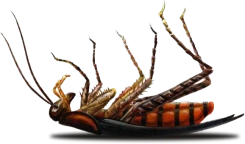Carpenter Bees vs. Bumblebees
If you are seeing large, black and yellow flying insects around outside your home, you may be worried about stinging or damaging pests like carpenter bees. It is important to distinguish between destructive carpenter bees and important pollinators like bumblebees. Carpenter bees and bumblebees look very similar to each other, but luckily our entomologists at Home Paramount have come up with a few characteristics to look for when deciding whether or not it is time to pick up the phone to identify and eliminate carpenter bee damage around your home.
Carpenter bees
Some carpenter bees are considered a threat to your home as wood-destroying organisms as these pests are notorious for boring holes into unfinished sections of wooden fences, decks, soffits and other similar structures on and around your house. Carpenter bees can be a problem when they are found nesting on the wooden parts of your home, creating damage as they chew through and tunnel into wood. As if the holes they leave behind aren’t aggravating enough, woodpeckers can move in to feed on the bee larvae and wreak even more havoc and destruction. In addition, yellow pollen stains can also be found under where they enter and exit the holes. The holes carpenter bees create are the entrances to their nests, or galleries, where the solitary female bee deposits her eggs and feeds her young. While only around a ½ inch in diameter, these galleries are normally around 4-6 inches deep, but reused holes can extend as deep as 10 feet, traveling with the grain of the wood. Outside of these galleries you will find the male bee aggressively defending his territory, chasing off his rivals and dive-bombing anyone who gets too close. Fear not, however, although his tactics are antagonistic, he is all talk; male carpenter bees lack a stinger and are unable to hurt you. In addition to their seemingly hostile behavior, male carpenter bees can be identified by a white patch on their face that is absent on females.
There are some key features that separate carpenter bees from our friendly pollinator, the bumblebee, which can easily be seen at a glance. While both bees are large and robust, carpenter bees lack hairs on the back end of their body (abdomen), which gives it a shiny black appearance. Carpenter bees will also have a bald patch on the middle of their back (thorax). Additionally, carpenter bees can often be seen hovering around wooden structures, especially those that are exposed and made of softer woods like pine.
Bumblebees
Unlike carpenter bees that bore into the wood and live in solitude, bumblebees build social hives with a queen underground. Bumblebees rarely get indoors, although some have been found in outdoor voids, such as electrical panel covers. Bumblebees are native pollinators that should be conserved due to the valuable ecological services they provide. Converse to carpenter bees, bumblebees are completely covered in hair, from the top of their head to the tip of their abdomen. These hairs usually have bands that are contrasting colors, the most common being yellow and black, but some are red, orange, white, or pink. Like the carpenter bee, only the female bee has a stinger, making the males equally harmless, although bumblebees are fairly docile in general.So, if you have lots of buzzing bees around your home, hopefully you have a yard full of productive, fuzzy pollinators. If you notice large, shiny and aggressive bees, you may be at risk of carpenter bee damage. If you suspect carpenter bees, or you are unsure, give your local Home Paramount branch a call and our experienced inspectors and technicians can help!


Why Choose Us?
Providing Reliable Pest & Wildlife Solutions Since 1939
At Home Paramount Pest Control, we have been dedicated to delivering reliable pest and wildlife management solutions for over 80 years. Our long-standing presence in the industry speaks volumes about our commitment to excellence and customer satisfaction. When you trust our team, you can always count on:
- Customized solutions to suit your specific needs
- Same-day service availability for pest infestation emergencies
- High-quality green products that are safe for the environment
- Complimentary pest inspections
- Affordable financing solutions tailored to your budget
Call us at 888-888-4663 to get started with a free pest inspection for your property today!
Learn More

